What is it cutaneous vasculitis?
Cutaneous vasculitis is a group of disorders in which there is inflammation. blood vessels on the skin. These may include capillaries, venules, arterioles and lymphatic.
- Cutaneous vasculitis has several different causes.
- There is a wide variety of clinical presentations.
- is associated with systemic vasculitis in a minority of patients
In most cases, no underlying cause is found and the disease is self-limited.
Classification of cutaneous vasculitis.
Capillaritis
- Progressive pigmented purple: the most common form of capillaritis
- itchy purple
- pigmented purpuric lichenoid skin disease
- Purpura annular telangiectodes
- Capillaritis in association with contact allergy
- Lichen aureus
Small vessel vasculitis
- Idiopathicdcarpet or infection-induced Cutaneous small vessel vasculitis (hypersensitivity vasculitis)
- Henoch-Scheitherpurple nilein
- Acute hemorrhagic edema of childhood
- Urticaria vasculitis
- Exercise-induced vasculitis
- Erythema elevatum diutinum
- Lymphocytic thrombophilic arteritis
- Evil one atrophic papulosis (Degos)
- Cryoglobulinemia
- Recurrent cutaneous necrotizing eosinophilic vasculitis
-
HAUNCHassociated vasculitis
- Microscopic polyangiitis
- Eosinophilic granulomatosis with polyangiitis / Churg-Strauss
- Granulomatosis with polyangiitis
- Lymphomatoid granulomatosis
Mid-vessel vasculitis
- Cutaneous polyarteritis nodosa
- Kawasaki's disease
- Nodular vasculitis
Large vessel vasculitis.
- Temporary arteritis
- Takayasu disease
- Giant cell arteritis
Who gets cutaneous vasculitis?
Cutaneous vasculitis can affect people of all ages and races. Some types of vasculitis have a predilection for certain age groups.
-
Acute hemorrhagic edema affects infants.
-
Henoch–Scheithernlein purpura affects children
-
Hypersensitivity vasculitis affects adults
- Older people are more likely to have diseases and medications that are potential causes of small vessel vasculitis.
What causes vasculitis?
Many different insults can cause an identical inflammatory answer within blood vessel wall. Three main mechanisms are proposed.
- Direct injury to the vessel wall by bacteria or virus
- Indirect injury due to activation of antibodies
- Indirect injury due to activation of complement, a group of proteins in the blood and tissue fluids that attack infections and foreign bodies.
What are the clinical features of vasculitis?
The clinical presentation of cutaneous vasculitis depends mainly on the size of the inflamed blood vessel.
-
Capillaritis presents as pigmented purpura, characterized by petechiae solving with hemosmosin statement.
- Small vessel vasculitis is characterized by palpable purple.
- Mid-vessel vasculitis is associated with nodules and livedo reticularis
- Large-vessel vasculitis infrequently produces cutaneous features.
Cutaneous vasculitis
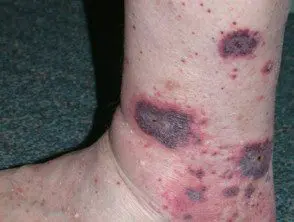
Cutaneous vasculitis

Cutaneous vasculitis
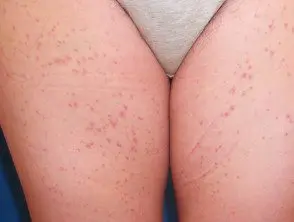
Cutaneous vasculitis
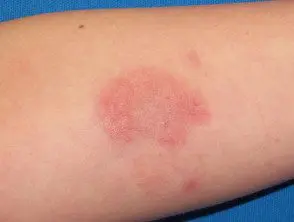
Cutaneous vasculitis
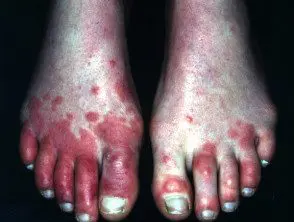
Cutaneous vasculitis
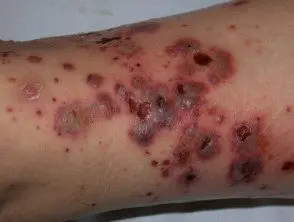
Cutaneous vasculitis
See more images of cutaneous vasculitis…
How is cutaneous vasculitis diagnosed?
The diagnosis of vasculitis can often be made based on its appearance without requiring further testing. sometimes a skin biopsy it is done to confirm the diagnosis, but this rarely explains what caused it, as vasculitis is the common endpoint of many different events.
Screening tests are required in most cases of vasculitis to identify any underlying cause and determine the extent of internal organ involvement.
What is the treatment for vasculitis?
Treatment depends on the severity of the disease and may include general measures, systemic corticosteroids, and immunomodulatory agents.
If the cutaneous vasculitis is a manifestation of systemic vasculitis, then treatment of the systemic disorder is required.
What is the prognosis for cutaneous vasculitis?
Vasculitis limited to the skin has a good forecast and most cases resolve over a period of weeks to months. Vasculitis may recur at variable intervals after the initial episode.
The prognosis of systemic vasculitis is dependent on the seriousness of the involvement of other organs. If vasculitis affects the kidneys, lungs, or brain, it can be fatal.

